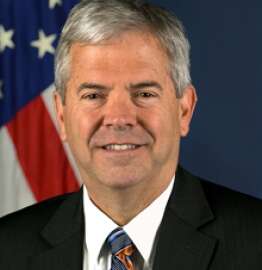Best listening experience is on Chrome, Firefox or Safari. Subscribe to Federal Drive’s daily audio interviews on Apple Podcasts or PodcastOne.
Watch out for the BHAGs at the Department of Transportation.
What is a BHAG, you may ask? Well, it stands for “big hairy audacious goals,” and it’s DOT Chief Information Officer Vicki Hildebrand’s plan to continue the agency’s IT modernization effort.
Hildebrand, who joined DOT in October, sees a lot of money that the agency is misspending and could be redirected toward new systems and better services.
“After about two or three months of observing, learning and asking questions, I got the team together and we talked about where we want to go, what our vision was and what it would take to get there,” Hildebrand said after a panel discussion at the CIO Summit sponsored by Foreign Affairs and the Advanced Technology Academic Research Center (ATARC) in Washington, D.C. “We started a series of six study teams and four work streams and we have official details assigned from the modes. Some of the CIOs leading them and some of the leadership from my organization are leading the teams making this a truly departmentwide initiative.”
She said nine BHAGs are under her Destinations Digital strategy:
- Strengthen the federal IT workforce
- Eliminate 1 million hours of burden
- Modernize multimodal processes
- Reduce malicious cyber incidents
- Shrink the IT footprint
- Implement intelligence software
- Promote transportation cybersecurity
- Expand self-service options
- Retain savings
“We are [very] federated with nine modes of transportation. We were operating very independently and we are bringing the modes together to develop departmentwide strategies,” she said. “We have more help desks across the agency than we should ever have. This is one example of an opportunity [to] collaborate on the back end.”
Spend wisely
DOT has so much misdirected spending that Hildebrand said when it comes to accessing potential dollars from the governmentwide central fund under the Modernizing Government Technology Act, she neither wanted nor needed any money.
“We have a lot of spend out there that we need to spend more wisely,” she said. “I’m actually doing many of the same things that are happening over at [Agriculture Department], but we are doing it internally and evoking the Federal IT Acquisition Reform Act (FITARA) to make that happen.”
Hildebrand was referring to USDA being a “lighthouse agency” to pilot the centers of excellence (CoE) effort under the IT modernization initiative from the Trump administration.
DOT launched the study teams earlier this month and they already have devised several potential short- and long-term changes.
“I was surprised when I got here because the government gets charged more than the private sector for IT services, and sometimes the services aren’t quite as good,” Hildebrand said. “I’m challenging that. I’ve seen the price tag from the private sector, and we need to compete more. I know part of that is it’s more challenging to procure in the government than in the private sector, but we have to shake things up. We are spending more money on things than we need to.”
Learning from the past
Hildebrand is picking up many of the initiatives started under former DOT CIO Richard McKinney, who left in January 2017. McKinney used FITARA to break through the culture plaque that had built up over the years by freezing IT spending across the agency until he could have better visibility, going so far as suspending a modal’s access to the internet until a cyber vulnerability was fixed.
Hildebrand said she has talked to McKinney and is taking advantage of the foundation he laid. And that is why her IT modernization efforts are not on hold until the BHAGs get going.
Hildebrand said her office recently consolidated some back-end functions and saved more than $1 million by reducing the number of contractors DOT worked with to provide the services.
“In terms of a new application, we just have a prototype at this point,” she said. “We had taken one of our applications off line and we had some issues with it and it has been down for some time. We needed to do something quickly and I wanted to use that opportunity to demonstrate that software doesn’t take multiple years and multiple millions of dollars to do.”
She said DOT used design-centered thinking to address this customer-facing system.
The modernization effort is not being done in a silo either. She said the acquisition, financial and human resources communities within DOT also are part of these teams.
“I always say IT exists for the mission and we can’t be successful without the support of the rest of the department,” Hildebrand said.
The biggest challenge she faces is, like any political appointee, to win over the career staff. She said to do that, it’s all about the quick victories such as the software or contractor consolidation examples.
“I understand the modal CIOs don’t know what to make of me. Part of that is because they have heard it before, and I think there is this sense that the ‘Christmas help,’ as I’ve been called, come in and talk big and nothing happens,” she said. “This is not the first time the career folks have been through this. If I were in that role, I’d understand who is this person and what are they doing with my job.”
That’s why she knows building up that body of accomplishments is so important. It also takes listening to career folks to keep her out of hot spots and create a very different DOT.
Copyright
© 2024 Federal News Network. All rights reserved. This website is not intended for users located within the European Economic Area.
